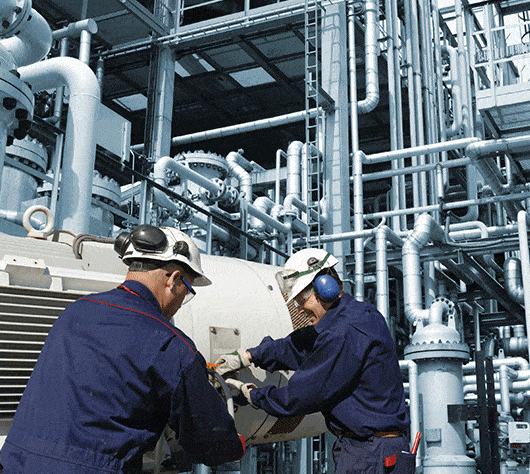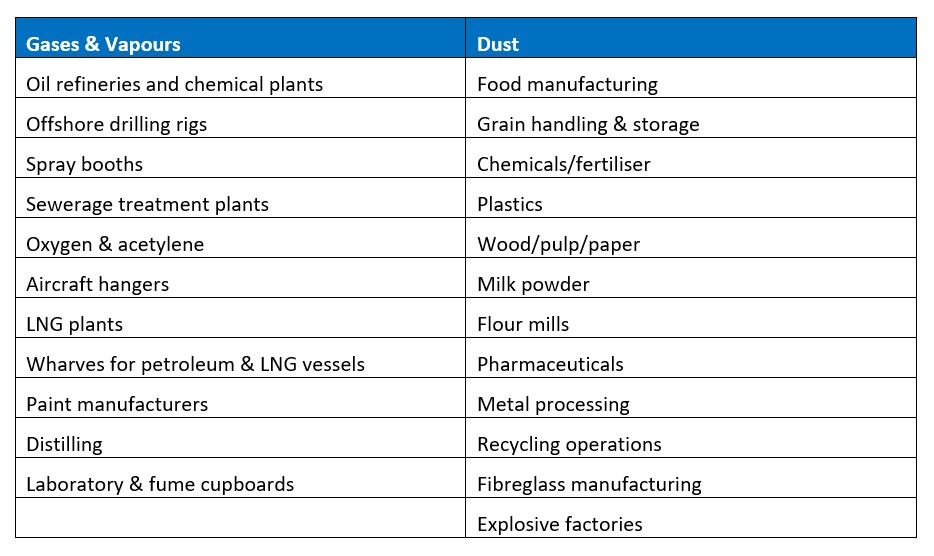What Does Roar Solutions Do?
What Does Roar Solutions Do?
Blog Article
Some Ideas on Roar Solutions You Should Know
In such an atmosphere a fire or surge is feasible when three fundamental conditions are fulfilled. This is commonly described as the "harmful area" or "combustion" triangle. In order to safeguard installations from a prospective explosion a method of evaluating and classifying a possibly hazardous location is called for. The purpose of this is to guarantee the correct selection and installment of equipment to eventually avoid an explosion and to ensure safety and security of life.

(https://leetcode.com/u/roarsolutions/)
No tools ought to be mounted where the surface area temperature level of the tools is higher than the ignition temperature of the offered hazard. Below are some typical dust harmful and their minimal ignition temperature level. Coal Dust 380C 225C Polythene 420C (thaws) Methyl Cellulose 420C 320C Starch 460C 435C Flour 490C 340C Sugar 490C 460C Grain Dirt 510C 300C Phenolic Resin 530C > 450C Aluminium 590C > 450C PVC 700C > 450C Residue 810C 570C The likelihood of the danger being existing in a focus high enough to cause an ignition will vary from place to place.
In order to identify this threat an installment is separated right into locations of risk relying on the quantity of time the dangerous is present. These locations are described as Zones. For gases and vapours and dusts and fibers there are three areas. Zone 0 Zone 20 A dangerous environment is extremely most likely to be existing and might exist for extended periods of time (> 1000 hours annually) or even continually Area 1 Area 21 An unsafe ambience is possible but not likely to be existing for lengthy durations of time (> 10 450 C [842 F] A classification of T6 indicates the minimum ignition temperature level is > 85 C [185 F] Dangerous area electric tools maybe designed for usage in higher ambient temperature levels. This would certainly suggested on the ranking plate e.g. EExe II C T3 Ta + 60C( This implies at 60C ambient T3 will certainly not be exceeded) T1 T1, T2, T3, T4, T5, T6 T2 T2, T3, T4, T5, T6 T3 T3, T4, T5, T6 T4 T4, T5, T6 T5 T5, T6 T6 T6 A T Class ranking of T1 suggests the maximum surface area temperature level produced by the tool at 40 C is 450 C. Presuming the associated T Course and Temperature ranking for the equipment are appropriate for the area, you can always use an instrument with an extra rigorous Division ranking than needed for the area. There isn't a clear solution to this question. It really does rely on the sort of devices and what repairs require to be carried out. Equipment with details test treatments that can not be done in the field in order to achieve/maintain 3rd party ranking. Need to come back to the manufacturing facility if it is before the equipment's service. Field Repair Service By Authorised Employee: Difficult screening may not be required nevertheless details procedures may need to be followed in order for the tools to keep its third celebration rating. Authorised personnel have to be utilized to carry out the work appropriately Fixing should be a like for like substitute. New part need to be considered as a direct substitute calling for no special testing of the devices after the repair is full. Each tool with a hazardous rating ought to be evaluated separately. These are outlined at a high level listed below, however for more thorough info, please refer straight to the guidelines.
Not known Incorrect Statements About Roar Solutions
The devices register is a comprehensive data source of tools documents that consists of a minimum set of areas to recognize each product's location, technological specifications, Ex-spouse category, age, and ecological data. This info is important for tracking and taking care of the tools effectively within harmful areas. On the other hand, for periodic or RBI tasting examinations, the grade will be a mix of Thorough and Close examinations. The ratio of Thorough to Close assessments will certainly be established by the Devices Danger, which is examined based on ignition risk (the probability of a source of ignition versus the probability of a flammable environment )and the dangerous area category
( Area 0, 1, or 2). This variation will also affect the resourcing demands for job prep work. Once Whole lots are defined, you can create sampling strategies based upon the example dimension of each Great deal, which describes the number of arbitrary tools things to be inspected. To establish the needed example dimension, two facets require to be assessed: the dimension of the Whole lot and the classification of examination, which suggests the level of initiative that must be applied( minimized, typical, or boosted )to the inspection of the see here Lot. By combining the category of examination with the Lot dimension, you can then develop the suitable denial criteria for a sample, suggesting the allowed number of malfunctioning products found within that example. For more information on this procedure, please refer to the Power Institute Standards. The IEC 60079 common recommends that the optimum interval in between evaluations must not surpass 3 years. EEHA inspections will certainly additionally be conducted beyond RBI projects as part of arranged maintenance and tools overhauls or repair services. These examinations can be attributed toward the RBI example dimensions within the impacted Lots. EEHA examinations are carried out to recognize faults in electrical tools. A weighted racking up system is necessary, as a single item of devices may have multiple mistakes, each with varying levels of ignition risk. If the mixed score of both inspections is much less than twice the fault rating, the Whole lot is considered acceptable. If the Great deal is still thought about unacceptable, it needs to go through a full evaluation or validation, which may cause stricter assessment protocols. Accepted Whole lot: The root causes of any type of mistakes are identified. If an usual failure mode is discovered, extra tools might call for maintenance. Mistakes are identified by severity( Security, Integrity, House cleaning ), guaranteeing that immediate issues are examined and dealt with promptly to alleviate any kind of influence on safety and security or operations. The EEHA database should track and videotape the lifecycle of faults in addition to the restorative activities taken. Executing a durable Risk-Based Examination( RBI )technique is critical for guaranteeing conformity and security in taking care of Electrical Equipment in Hazardous Areas( EEHA) (eeha). Automated Mistake Rating and Lifecycle Monitoring: Easily take care of mistakes and track their lifecycle to enhance assessment precision. The intro of this assistance for risk-based examination further enhances Inspectivity's placement as a best-in-class solution for regulatory compliance, along with for any kind of asset-centric examination use case. If you have an interest in discovering more, we invite you to request a demonstration and discover just how our service can transform your EEHA administration procedures.
Our Roar Solutions Ideas

In regards to eruptive danger, a harmful area is an environment in which an eruptive environment is existing (or might be anticipated to be existing) in amounts that call for unique safety measures for the building, setup and use of tools. eeha courses. In this article we check out the difficulties dealt with in the work environment, the danger control measures, and the required proficiencies to work safely
It issues of modern-day life that we produce, keep or take care of a variety of gases or fluids that are deemed combustible, and a range of dirts that are deemed flammable. These substances can, in certain problems, form explosive environments and these can have major and awful consequences. The majority of us know with the fire triangular remove any type of one of the 3 elements and the fire can not take place, however what does this mean in the context of dangerous locations? When breaking this down right into its simplest terms it is basically: a combination of a particular amount of release or leakage of a particular material or material, combining with ambient oxygen, and the visibility of a resource of ignition.
In a lot of instances, we can do little regarding the levels of oxygen in the air, but we can have significant impact on sources of ignition, as an example electrical equipment. Dangerous areas are documented on the harmful location classification illustration and are recognized on-site by the triangular "EX-SPOUSE" indicator. Below, amongst other key details, areas are divided into three types depending on the risk, the possibility and duration that an explosive ambience will exist; Area 0 or 20 is regarded the most hazardous and Zone 2 or 22 is considered the least.
Report this page